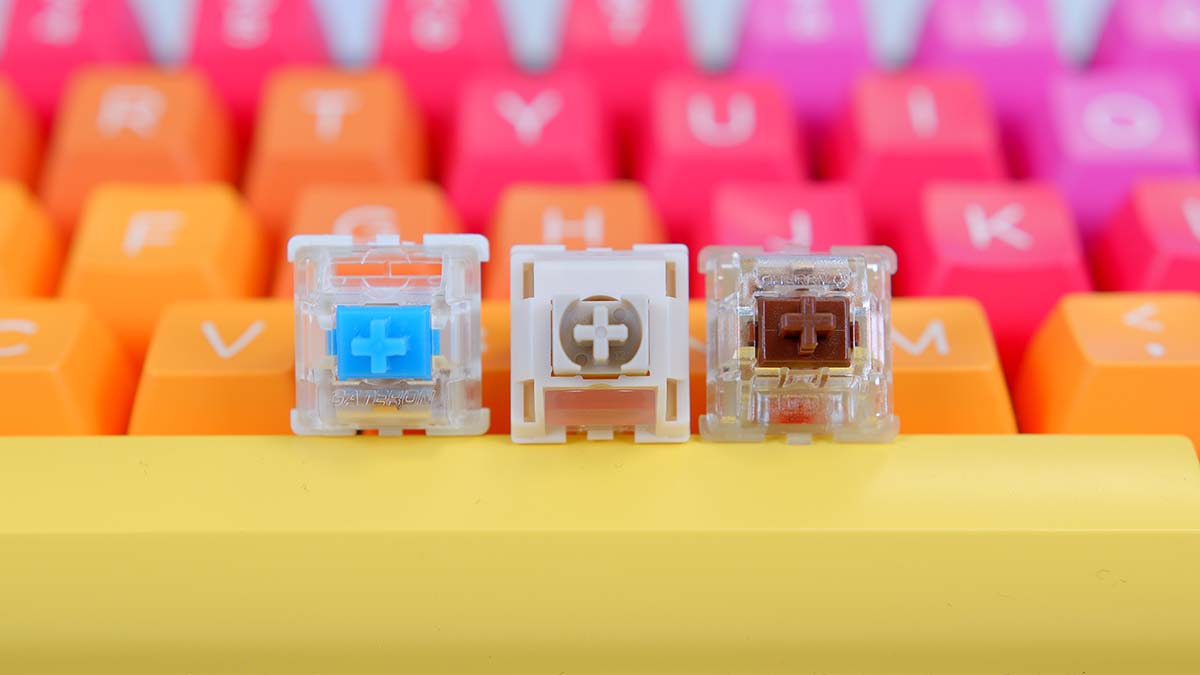Demystify keyboard switches with a beginner’s guide in a simple and informative manner. Understand the nuances of different switch types.
Are you new to the world of mechanical keyboards and feeling overwhelmed by the terminology? Fear not, as we break down the complex world of keyboard switches for beginners. Whether you are a gamer, typist, or casual user, understanding keyboard switches is crucial for finding the perfect typing experience tailored to your needs.
In this guide, we will explore the basics of mechanical switches, including the different types available, their characteristics, and how they impact your typing or gaming performance. By the end, you will have a clear understanding of the key factors to consider when choosing the right keyboard switch for you.
Types Of Keyboard Switches
Understanding the different types of keyboard switches is essential for anyone looking to purchase a new keyboard. Each type of switch has its own unique feel and sound, making it important for users to choose the right one that suits their preferences and needs. In this guide, we will demystify the types of keyboard switches and provide a comprehensive overview of membrane, mechanical, and scissor switches.
Membrane Switches
Membrane switches are commonly found in budget-friendly keyboards. They use a flexible membrane layer that contains three separate layers – the top membrane, the bottom membrane, and a conductive trace. When a key is pressed, the top membrane is pushed down to make contact with the bottom membrane, completing the circuit and registering the keystroke. These switches are generally quieter and have a softer tactile feel compared to mechanical switches. However, they may lack the durability and precision associated with mechanical switches.
Mechanical Switches
Mechanical switches are renowned for their responsive feedback and durability. They are constructed with individual mechanical components for each key, providing a distinct tactile feedback and audible click when pressed. The mechanism consists of a spring and stem that actuates the keypress, resulting in a satisfying and precise typing experience. With various types such as clicky, tactile, and linear switches, mechanical keyboards offer a wide range of customization to cater to different user preferences.
Scissor Switches
Scissor switches are commonly found in laptop keyboards due to their slim profile and low profile keys. They utilize a scissor-like mechanism that stabilizes each key, resulting in improved key stability and reduced wobbling. This type of switch offers a shallow key travel and a quiet typing experience, making it suitable for individuals who prefer a more discreet and portable keyboard. Scissor switches are often praised for their longevity and the tactile response they provide despite the reduced key travel.
How Keyboard Switches Work

In this beginner’s guide, we demystify how keyboard switches work, shedding light on their inner workings and functionality. Explore the mechanics behind these essential components for a deeper understanding of your keyboard’s performance.
Membrane Switches Operation
A membrane keyboard is the most basic and common type of keyboard found on laptops and low-cost keyboards. It consists of a flexible membrane layer with conductive traces that form a grid. When a key is pressed, the top layer of the membrane makes contact with the bottom layer, completing the circuit and registering the keypress.
Here’s a step-by-step breakdown of how membrane switches work:
- The user presses a key on the keyboard.
- The keypress applies pressure on the top layer of the membrane.
- This causes the top layer to deform and make contact with the bottom layer.
- The conductive traces on the top and bottom layers complete the circuit, creating an electrical connection.
- The electrical signal is then sent to the computer, which registers the keypress and performs the corresponding action.
Mechanical Switches Operation
Mechanical switches are known for their durability, tactile feedback, and distinct clicking sound. They consist of individual switches under each keycap, which are usually made of plastic stems and metal springs. When a key is pressed, the stem pushes down on the spring, causing it to compress. This movement registers the keypress.
Here’s how mechanical switches work:
- The user presses a key, exerting force on the keycap.
- The keycap pushes down on a plastic stem connected to a metal spring.
- This causes the spring to compress, storing potential energy.
- Once the spring reaches its activation point, it registers the keypress.
- The spring then rebounds, pushing the keycap back up and resetting the switch.
Scissor Switches Operation
Scissor switches are commonly found in laptop keyboards and offer a more stable typing experience compared to membrane keyboards. They consist of two intersecting plastic pieces with a scissor-like mechanism that provides better key stability.
Here’s a breakdown of how scissor switches work:
- The user presses a key, applying downward pressure.
- The keycap pushes down on the scissor mechanism, causing it to pivot.
- The scissor mechanism transfers the force to a rubber dome, which eventually makes contact with the PCB beneath it.
- Once the rubber dome compresses enough, it registers the keypress.
- Releasing the key allows the scissor mechanism to return to its initial position.
Key Factors To Consider
When choosing a keyboard switch, it’s important to consider several key factors that can greatly impact your typing experience. These factors include tactility and feedback, actuation force, and durability and lifespan.
Tactility And Feedback
Tactility and feedback refer to the feel and response of a key when pressed. Some switches provide a tactile bump to indicate actuation, while others offer a smooth keystroke without feedback.
Actuation Force
Actuation force is the amount of pressure required to register a keypress. Lighter switches are ideal for fast typists, while heavier switches offer more resistance.
Durability And Lifespan
When it comes to durability and lifespan, it’s essential to choose switches that can withstand heavy daily use and have a long lifespan to ensure lasting performance.
Applications Of Different Switches

Keyboard switches, such as mechanical, membrane, and scissor switches, have diverse applications across various devices and industries. Understanding the differences and benefits of each switch type can help beginners make informed decisions when selecting a keyboard for gaming, typing, or office use.
Gaming Keyboards
In the realm of gaming, fast and precise keystrokes are essential. Switches such as Cherry MX Speed Silver are preferred for gaming to facilitate rapid response times.
Typing And Office Use
For typing and office work, quiet and tactile switches are often favored. Options like Cherry MX Brown strike a balance between feedback and noise level.
Specialized Keyboards
In specialized keyboards, custom switches cater to specific needs. Topre switches, for example, offer a unique hybrid feel appealing to enthusiasts.
Customization And Personalization
When it comes to keyboards, customization and personalization are two key factors that make the typing experience truly unique. The ability to tailor your keyboard to your preferences can enhance comfort, efficiency, and even aesthetics. In this section, we will explore two aspects of customization: keycap materials and profiles, as well as switch modifications and lubrication.
Keycap Materials And Profiles
The material of your keycaps can significantly impact the feel and sound of each keypress. There are various materials commonly used, including ABS (Acrylonitrile Butadiene Styrene), PBT (Polybutylene Terephthalate), and even specialty materials like resin.
ABS keycaps are often smoother and have a softer sound, but they may become shiny over time. On the other hand, PBT keycaps have a more textured feel and are more resistant to wear and tear, making them a popular choice among enthusiasts seeking durability.
In addition to material, keycap profiles determine the shape and contour of each key. Common profiles include OEM, Cherry, and SA. OEM profile is the most widely used, offering a slightly curved top for comfortable typing. Cherry profile provides a more compact and low-profile design, while SA profile boasts a sculpted shape that typists love for its ergonomic benefits.
Switch Modifications And Lubrication
If you want to take your customization to the next level, switch modifications and lubrication can greatly improve the overall typing experience. These modifications involve fine-tuning the switches to your liking, such as adjusting the actuation force or reducing the key wobble.
One popular modification is the installation of aftermarket springs, which can change the feel of the switch by altering the actuation force required. Lubricating the switches with the right lubricant can reduce friction, resulting in a smoother and quieter keystroke.
It’s worth noting that switch modifications and lubrication require some technical knowledge and expertise. If you’re new to the world of keyboard customization, it’s advisable to start with basic modifications and gradually explore more advanced techniques.
Popular Keyboard Switch Brands
Curious about keyboard switch brands? From the timeless Cherry MX to the innovative Razer switches, the world of keyboard switches offers a variety of options to suit every typing preference. Understanding these popular brands can help beginners navigate the diverse world of keyboard switches.
When it comes to keyboard switches, it’s crucial to understand the different brands available in the market. Let’s delve into some of the most popular keyboard switch brands, including Cherry MX Series, Razer Switches, and Logitech Romer-G.
Cherry Mx Series
Cherry MX Series is renowned for its durability and tactile feedback, making it a top choice for gamers and typists alike. These switches are available in various colors, each offering a unique typing experience.
Razer Switches
Razer Switches are highly regarded for their fast actuation and smooth keystrokes. Designed specifically for gaming, Razer Switches provide a competitive edge with their responsiveness and precision.
Logitech Romer-g
Logitech Romer-G switches are known for their quiet operation and tactile feel. These switches are designed to enhance typing speed and accuracy, making them a popular choice for both work and play.
Debunking Common Myths

Demystify keyboard switches with our beginner’s guide, debunking common myths. Gain a better understanding of switch types, their mechanics, and how they affect performance. Discover the truth behind popular misconceptions in an easy-to-understand format.
Loudness Equals Better Quality
One common misconception is that louder keyboard switches are of higher quality. In reality, volume does not correlate with performance or durability.
All Mechanical Switches Are The Same
Not all mechanical switches are created equal. There are various types with distinct characteristics that cater to different preferences and needs.
Making An Informed Choice
When it comes to choosing the right keyboard for your needs, understanding keyboard switches is essential. Keyboard switches determine the feel and response of each key, making them a crucial factor to consider when purchasing a new keyboard. Testing out switches and considering personal preference are two important aspects that can help you make an informed choice. Let’s explore these factors in detail.
Testing Out Switches
Before making a decision, it’s important to get hands-on experience with different keyboard switches. Many electronics stores have display units available to try out, allowing you to feel the difference between switches yourself. Testing out switches allows you to determine which type suits your typing style and preferences best.
If you don’t have access to physical stores, there are online resources and reviews that can provide valuable insights into different switch types. These resources often describe the tactile feedback and sound produced by each switch, allowing you to get a virtual sense of what it would be like to type on them.
| Switch Type | Tactile Feedback | Typing Sound |
|---|---|---|
| Cherry MX Blue | Tactile and Clicky | Audible Click |
| Cherry MX Brown | Tactile but Quiet | Soft Thump |
| Cherry MX Red | Linear but Smooth | Silent |
Considering Personal Preference
When selecting a keyboard switch, personal preference plays a crucial role. Everyone has different typing styles and preferences, so what may work for one person may not work for another. It’s important to take into account factors such as typing speed, noise tolerance, and typing environment when considering personal preference.
For example, if you type fast and prefer a more responsive typing experience, switches with a shorter actuation point, such as Cherry MX Red, may be more suitable for you. On the other hand, if you work in a quiet office environment or have a low tolerance for noisy keyboards, switches like Cherry MX Brown may be a better fit as they provide tactile feedback without the loud click.
- Typing Speed: Consider your typing speed and whether you prefer a light or heavy actuation force.
- Noise Tolerance: Think about your tolerance for keyboard noise and whether a clicky or quiet switch would be more comfortable for you.
- Typing Environment: Take into account your typical typing environment, such as an office or home, and whether noise would be a concern for those around you.
By considering these personal preferences, you can make a more informed decision and choose a keyboard switch that suits you best. Keep in mind that there are no right or wrong answers when it comes to personal preference, so it’s important to prioritize your own comfort and satisfaction.
Frequently Asked Questions On Demystifying Keyboard Switches: A Beginner’s Guide
Is Changing Keyboard Switches Easy?
Yes, changing keyboard switches is easy as long as you have the right tools. Just desolder the old switch and solder in the new one.
What Are The Best Switches For Typing Accurately?
The Cherry MX switches are the best for typing accuracy due to their tactile feedback and precise actuation point.
Are Red Blue Or Brown Switches Better For Programming?
Red switches are better for programming because they offer a tactile feedback, making it easier to feel when a key is activated. Blue switches have an audible click, which can be distracting. Brown switches are a compromise between the two.
What Is The Most Satisfying Keyboard Switches?
The most satisfying keyboard switches are subjective and depend on personal preference. Some popular options include Cherry MX, Gateron, and Kailh switches, which offer a range of tactile feedback and actuation forces to suit different typing styles. Ultimately, it’s best to try out different switches to find the one that feels most satisfying to you.
Conclusion
To sum it up, understanding the different types of keyboard switches is crucial for both beginners and experienced users. By comprehending the varied characteristics of switches like mechanical, membrane, and scissor, you can make an informed decision when purchasing a keyboard that suits your needs and preferences.
Remember to consider factors such as typing experience, gaming requirements, and personal comfort. With this knowledge, you’ll be well-equipped to embark on your journey to find the perfect keyboard switch. Happy typing!



